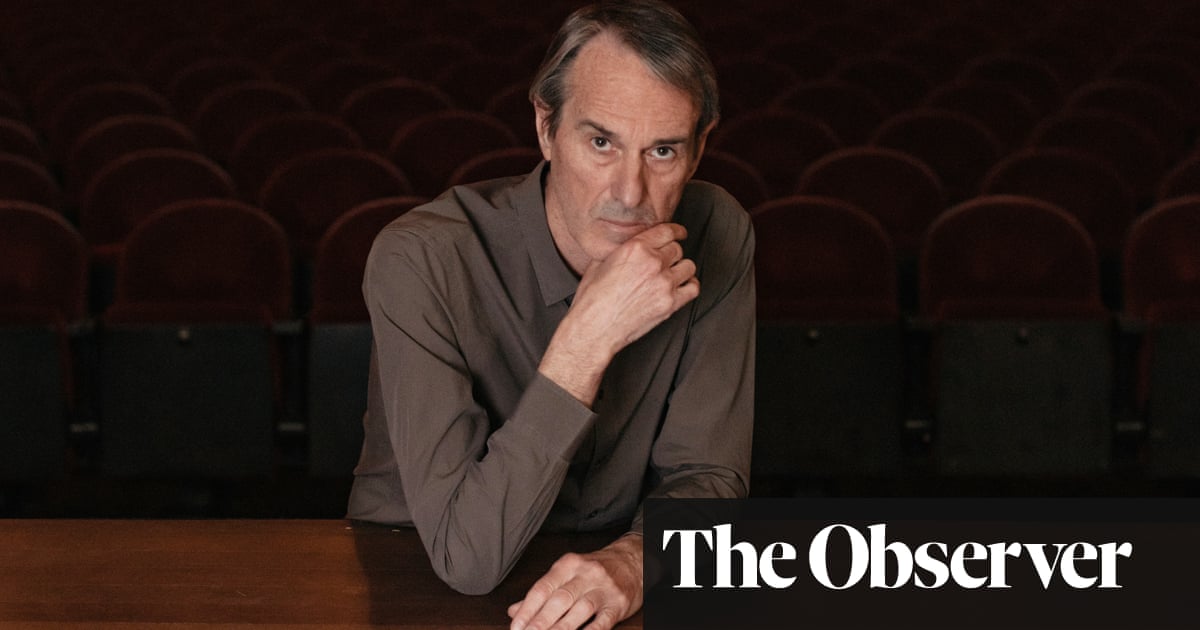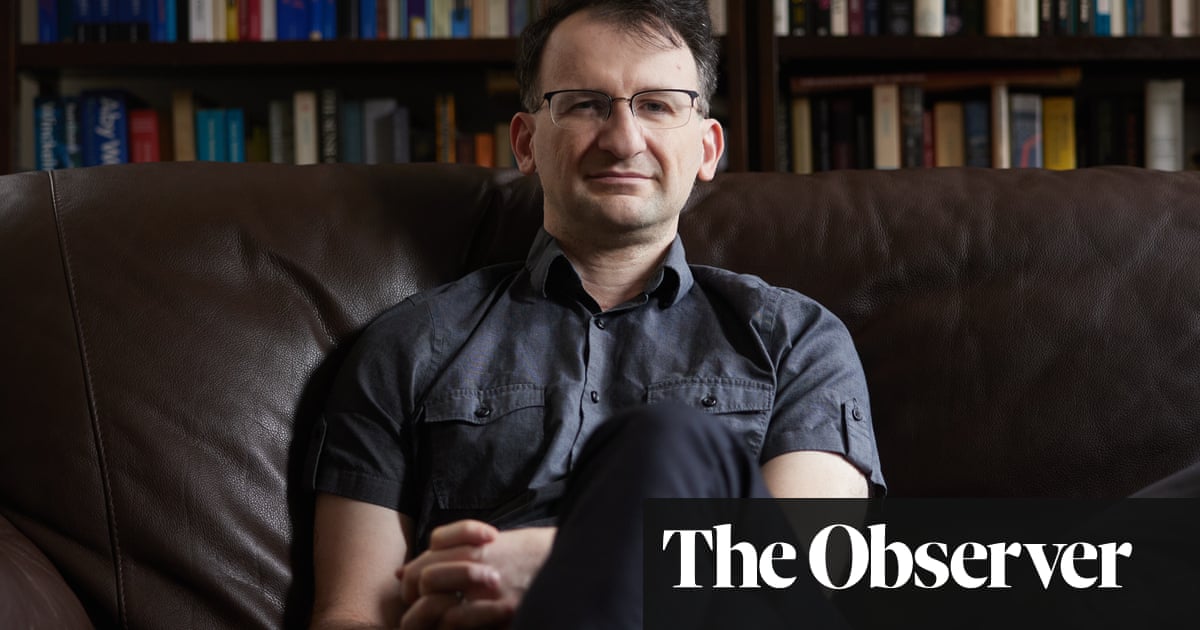
Where does Ivo van Hove find the time? The ubiquitous Belgian director’s newly announced version of The Human Voice by Jean Cocteau will be staged in London in March, starring Ruth Wilson. His subterranean take on Tennessee Williams’ The Glass Menagerie, made for the Odéon in Paris, has just run at his ensemble’s home, the Internationaal Theater Amsterdam. Several of his shows for ITA’s repertory continue to tour. His epic revenge drama Age of Rage – about the Trojan war – is planned for spring at the Barbican, where his take on Thomas Mann’s Death in Venice was scuppered by the pandemic.
He is one of Europe’s most in-demand stage directors, but while his reputation was made on radical, virtuoso versions of ancient Greek tragedies and weighty American dramas, his rise is also inseparable from his passion for cinema. Ingmar Bergman, John Cassavetes and Luchino Visconti are among the auteurs whose films he has reimagined for the stage with his partner, the designer Jan Versweyveld.
Those collaborations have become the subject of an exhibition, All About Theatre About Film, put together by the duo at Amsterdam’s canal-side Eye Filmmuseum. It’s a show that leaves you giddy: desperate to watch or rewatch the films that inspired them, vexed about the stage productions you missed, and bowled over by their development of intricate, thrumming worlds – culminating in the TV studio-cum-working restaurant that filled the National’s Lyttelton theatre for Network in 2017.
In the museum’s vast gallery space, the pair have created a number of immersive rooms each with its own distinctive mise-en-scène to evoke the cinema-inspired stage productions. You walk from the detached, cool-blue room memorialising their Antonioni Project – based on three films by the Italian director – and on to the messy domestic realm of Bergman’s Scenes from a Marriage, where you sit on scattered cube chairs to watch footage of Van Hove’s actors unleashing accusations, festering resentments and murderous dreams in his sprawling adaptation. The rooms contain original props, costumes and sound recordings – played on directional speakers – as well as photographs and notebooks. Many of them also juxtapose scenes from the original films with corresponding footage of the stage versions.
What comes through is the consistency not just of Van Hove’s style – he has developed an increasingly sophisticated use of live video on stage – but also of his themes. In a 2004 fax to Bergman, exhibited in the Scenes from a Marriage room, he writes: “Family life … has always been the central core of my work as a director … The inevitable burden and haven it presents in man’s life are a central starting point to speak about society and politics.” He could be talking about the Wingfield family who have burrowed underground in Versweyveld’s earthy set for Tennessee Williams’ The Glass Menagerie. Or the cocoon-like court of Ludwig II of Bavaria, whose tragedy – filtered through Visconti – he staged in Munich in 2011. Or the hardscrabble family who settle in Milan in Visconti’s Rocco and His Brothers, which he staged with the audience surrounding a huge square that doubled as dining table and boxing ring. That table dominates one room of the exhibition, holding piles of dirty dishes and a pot of spaghetti bolognese.
In Rocco, the actors came together to eat a meal on stage and this exhibition attracts our senses, too. A citronella diffuser is used in the first room, which marks Van Hove’s 1999 production India Song, based on Marguerite Duras’s experimental film. With warm lighting from above and a carpet beneath our feet, it evokes the woozy romance spun by Duras, whose characters are represented by a black gown and a white linen suit, both by Dries van Noten, hanging on mannequins. The installation complements the rather grainy archive footage of the original staging (a reminder how far filmed theatre has come) to give an idea of what it would have felt like to watch the intimate production, which invited audience members to sit on the stage.
A later room, devoted to Van Hove’s version of Visconti’s thriller Obsession, is filled with a heavy rusty smell. A huge grimy engine is suspended from the ceiling, as in the 2017 production, in which Jude Law played a drifting mechanic whose passionate affair leads him to murder. Here, the engine resembles a projector as it hangs in front of a screen with clips from the production; a huge shadow cast on the floor bringing to mind the oil that was spilled on stage. I found much of the Barbican show tacky, not least Law’s frantic getaway on a treadmill. But in the tighter space of the exhibition room, with clips of the show at cinema-screen size, you see the quality of the performances. A sense of claustrophobia encroaches in a manner that is perhaps impossible on the vast, exposing Barbican stage where Obsession was presented.
The hulking engine could be an installation in itself and seems charged with the essence of Obsession: a sweaty, pungent and rather lumbering production. The idea that objects can encapsulate a play is a notion pursued in speeches chosen from Van Hove’s adaptation of After the Rehearsal, and the original film by Bergman, which are screened next to each other. The director Henrik tells actor Anna that the furniture around them in the theatre that has previously been used for Strindberg productions – a stool from Miss Julie, chairs from A Dream Play – are “acquaintances all” and that these objects bring with them resonances of their previous uses on stage. This is an idea explored by Strindberg himself in A Dream Play, where an old shawl is said to have absorbed years of sorrow. But actors bring a residue of their old roles, too – something that is felt all the more profoundly in an ensemble like ITA whose core actors reappear from room to room in the exhibition, inviting us to make connections between their roles.
We watch the clips from After the Rehearsal while sitting on “the Hedda Gabler sofa” – that is, the stained Ikea-style couch used by Van Hove in his version rather than the elegant sofa used by Bergman. Linger for long enough and memories come back of the interiors in Van Hove’s Hedda Gabler with Ruth Wilson at the National: the solemn piano, the framed gun, the flowers stapled to the walls. The exhibition’s room for Bergman’s Persona, which he staged as a double bill with After the Rehearsal, presents another installation, this time using an artwork that inspired Van Hove. A waxy torso sculpted by Berlinde de Bruyckere is presented in a cabinet that stands on a flooded stage, its reflection in the water rippling to evoke melting flesh and chiming with Persona’s inquiry into blurring identities.
As well as the copious handwritten notes by Van Hove and the meticulous model boxes and photos by Versweyveld, we are given a hands-on sense of their approach to theatre-making, with clips from a documentary about the making of Husbands, one of three John Cassavetes stagings represented together in a single room. We watch footage of rehearsals from rows of old cinema-style seats but a huge blown-up photo on the adjacent wall reminds us of Van Hove’s radical immersion of audiences into the world of his plays. Theatregoers for Faces reclined together on beds to watch the drama unfold around them.
It’s a reminder of an age before social distancing and the threat that the pandemic continues to pose to theatre. The day after I saw the exhibition and Van Hove’s Glass Menagerie, the Netherlands brought forward its curfew for evening entertainment, leading ITA to cancel shows for the weeks ahead. The exhibition remains open daily and deserves a European tour of its own (the Barbican would be the natural space in London, considering its past presentations of the duo’s pair and their stylish merging of design, film and theatre). But part of the exhibition’s achievement is how well it fits the space of the stunning Eye Filmmuseum. Its final coup de theatre is how you emerge, from a room containing the news desk of Network’s mad-as-hell Howard Beale and footage of the huge working restaurant at the Lyttelton, into the museum’s own restaurant, with its tiered seating, cool angular lines and installation-style lighting clusters by Olafur Eliasson. It is a world as if imagined by Van Hove and Versweyveld themselves.
All About Theatre About Film is at the Eye Filmmuseum, Amsterdam, until 23 January.












